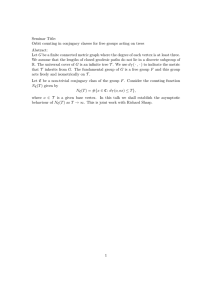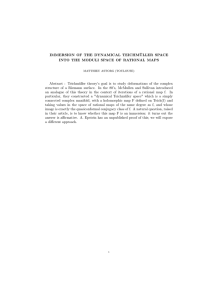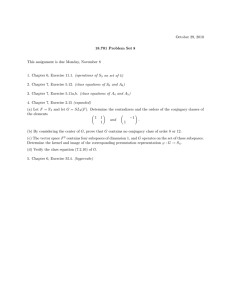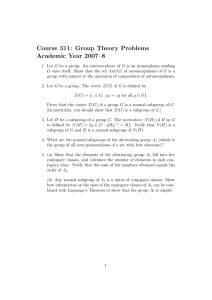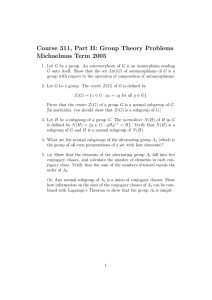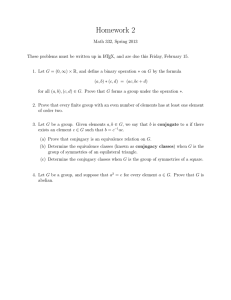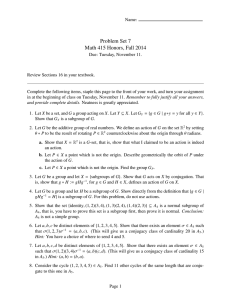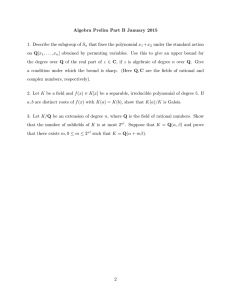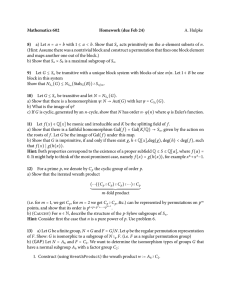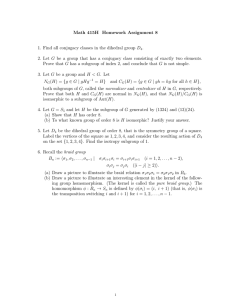an inductive schema for computing conjugacy classes in
advertisement
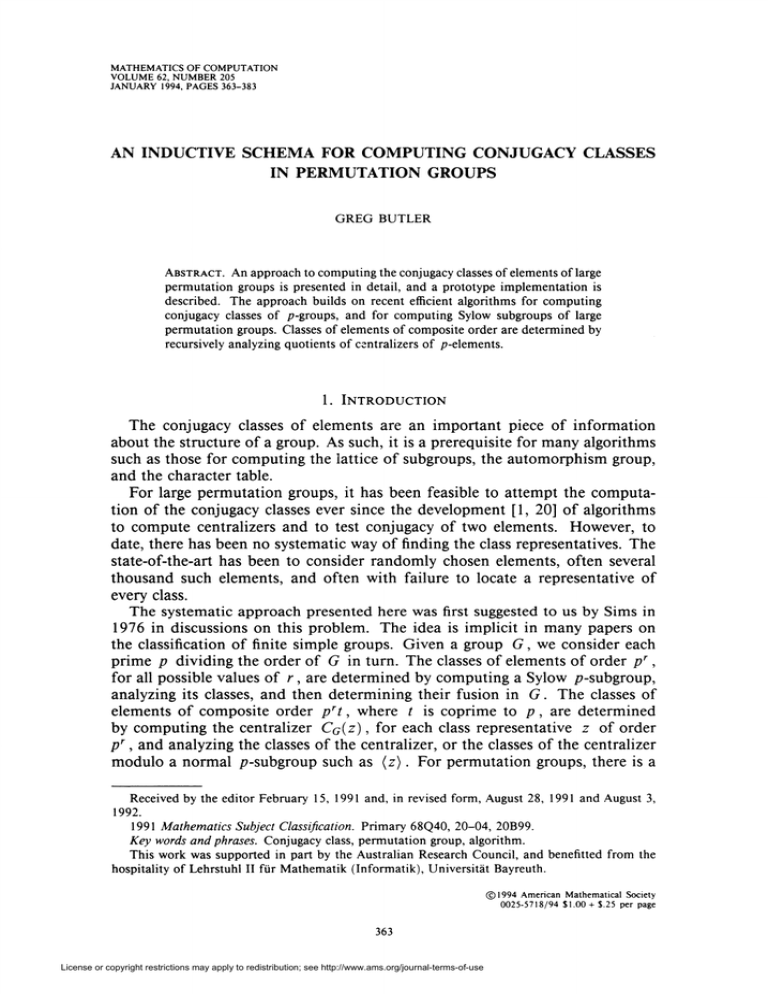
mathematics of computation
volume 62,number 205
january 1994,pages 363-383
AN INDUCTIVE SCHEMA FOR COMPUTING CONJUGACY CLASSES
IN PERMUTATION GROUPS
GREG BUTLER
Abstract.
An approach to computing the conjugacy classes of elements of large
permutation groups is presented in detail, and a prototype implementation is
described. The approach builds on recent efficient algorithms for computing
conjugacy classes of p-groups, and for computing Sylow subgroups of large
permutation groups. Classes of elements of composite order are determined by
recursively analyzing quotients of centralize« of p-elements.
1. Introduction
The conjugacy classes of elements are an important piece of information
about the structure of a group. As such, it is a prerequisite for many algorithms
such as those for computing the lattice of subgroups, the automorphism group,
and the character table.
For large permutation groups, it has been feasible to attempt the computation of the conjugacy classes ever since the development [1, 20] of algorithms
to compute centralizers and to test conjugacy of two elements. However, to
date, there has been no systematic way of finding the class representatives. The
state-of-the-art has been to consider randomly chosen elements, often several
thousand such elements, and often with failure to locate a representative of
every class.
The systematic approach presented here was first suggested to us by Sims in
1976 in discussions on this problem. The idea is implicit in many papers on
the classification of finite simple groups. Given a group G, we consider each
prime p dividing the order of G in turn. The classes of elements of order pr,
for all possible values of r, are determined by computing a Sylow p-subgroup,
analyzing its classes, and then determining their fusion in G. The classes of
elements of composite order prt, where t is coprime to p, are determined
by computing the centralizer Cg(z) , for each class representative z of order
pr, and analyzing the classes of the centralizer, or the classes of the centralizer
modulo a normal p-subgroup such as (z). For permutation groups, there is a
Received by the editor February 15, 1991 and, in revised form, August 28, 1991 and August 3,
1992.
1991MathematicsSubjectClassification.Primary 68Q40, 20-04, 20B99.
Key words and phrases. Conjugacy class, permutation group, algorithm.
This work was supported in part by the Australian Research Council, and benefitted from the
hospitality of Lehrstuhl II für Mathematik (Informatik), Universität Bayreuth.
©1994 American Mathematical Society
0025-5718/94 $1.00 + $.25 per page
363
License or copyright restrictions may apply to redistribution; see http://www.ams.org/journal-terms-of-use
364
GREG BUTLER
natural quotient of the centralizer given by its action on the cycles of z . Again,
the fusion of these classes in G must be determined.
The major contributions of this paper are
• a new theoretical result, Theorem 5.1.1, which eliminates conjugacy
testing when determining the classes of elements of composite order;
• a strategy to process the primes in an appropriate order and restrict the
composite orders to those involving only certain primes;
• a framework for the overall computation so that the existing theory and
ad hoc hand methods can be applied by a computer;
• a prototype implementation in Cayley, v3.7 [8] to demonstrate the feasibility of the computer application of the inductive schema, and to
identify the computational bottlenecks.
A study of the complexity of the problem is not included. It is difficult to
see how the computation of the conjugacy classes could avoid the computation
of centralizers, or testing whether two elements are conjugate. The complexity
of these simpler problems is still open [13].
The implementation of the approach has been made possible by recent progress [7] in computing Sylow subgroups of large permutation groups; in converting the representation of a p-group from a permutation group to a pc presentation [4, 6, 14]; and in computing the conjugacy classes of elements of a
p-group given by a pc presentation [9].
The prototype implementation computes the 116 classes of PSL(5, 3) of
degree 121 and order 237,783,237,120 = 29310511213 in 14 minutes on a Sun
Sparestation, and computes the 60 classes of Conway's second sporadic simple
group Co2 of degree 2300 and order 42,305,421,312,000 = 2183653711 23 in
2.5 hours.
The paper continues by presenting the necessary background on conjugacy
classes and on computational group theory, and then describing the inductive
schema in overview. The following sections then discuss the theory, algorithms,
and present examples, for each of the major subproblems. The prototype implementation is described and some experimental results presented. Opportunities
for further work are discussed before concluding the paper.
2. Background
This section presents the necessary background notation, definitions, and
computational tools which we will need. The reader is referred to [12, 22] for
elementary definitions and results from group theory. The engineering aspects
of developing and implementing the algorithm require some appreciation of
what can be done cheaply, or not so cheaply, using the current state-of-the-art
algorithms for subtasks.
Let G be a finite group. Let g be an element of G. Let KG(g) denote the conjugacy class {h~xgh \ h € G} of g in G, and define KrG(g) =
\J{z)=(g)^G{z) to be the rational class of g in G. The rational class is a disjoint union of conjugacy classes KG(gm¡), for certain integers mn=l, mx , ... ,
ms between 1 and the order of g. The length of each conjugacy class is determined by the centralizer CG(g), and the integers m¡ are determined by the
structure of the abelian group NG((g))/CG(g) ■
License or copyright restrictions may apply to redistribution; see http://www.ams.org/journal-terms-of-use
COMPUTING CONJUGACYCLASSESIN PERMUTATIONGROUPS
365
Define the Gabis group, GalG(g), of g e G to be the subgroup of Aut({g))
isomorphic to NG((g))/CG(g).
The classes within the rational class KrG(g)
are in 1-1 correspondence with the cosets of the Galois group, GalG(g), in the
automorphism group, Aut((g)).
Consider the structure of the automorphism group of a cyclic group Z„ of
order n .
Proposition 2.0.1 ([16, Satz 13.19, page 84]). (1) Aut(Z„) is isomorphic to the
multiplicative group of Z/nZ.
(2) If n = «i«2 • • • 1/ with the n¡ pairwise coprime, then
Aut(Z„) ~ Aut(Z„,) x Aut(Z„2) x • • ■x Aut(Z„().
(3) For p > 2, Aut(Zpr) is a cyclic group of order pr~x(p - 1).
(4) For r>3,
Aut(Z2')
and we can take 5 mod 2r and -1
direct factors.
~ Z2r-2 x Z2
mod 2r as generators of the respective
(5) Aut(Z4) ~ Z2, and Aut(Z2) is the trivial group. O
Let Eg denote the obvious isomorphism between Aut((g)) and the multiplicative group of Z/nZ, where n = \g\. Hence, &g(Ga\G(g)) is a subgroup of the multiplicative group of Z/nZ. If x e NG((g)) or x is a coset
in NG((g))/CG(g), then eg(x) will denote the corresponding element of
eg(Ga\G(g)). If n = qt, where q and t axe coprime, then Aut(Z„) ~
Aut(Z9) x Aut(Z,). Hence, there is a projection |f from the multiplicative
group of Z/nZ to the multiplicative group of Z/tZ. We denote the inverse
embedding by ]" .
Corollary 2.0.1. Let S be a Sylow p-subgroup of G and let g e G have order
Pr ■
(1) For p > 2 and r > 1, regard Aut(Zpr) as Zp,-\ x Zfj,_X). There exists
gx eSr\KG(g) suchthat Gals(gi) is the Zp,~\-component of GalG(gx).
(2) For p > 2 and r > 1, the Z(p_Xycomponent of Galc(g) projects faithfully to the Z(j,_X)-componentof GalG(gp).
(3) For p = 2, there exists gx e S n KG(g) such that Gals(gi) =
Galctei). D
For cases ( 1) and (3) of the corollary, we may take gx e SriKG(g) such that
Cs(g\) is a Sylow p-subgroup of CG(gx) and the normalizer Ns((gx)) is as
large as possible. In case (2) of the corollary, if CG(g) = CG(gp), then take an
element x e G which normalizes gp and (modulo the centralizer) generates
the Z(p_i)-component of Ga\G(gp). The generator of the Z^.^-component of
GalG(g) is a power of x .
Proposition2.0.2. If H < G and h e H, then Gal//(A)< GalG(h). D
Corollary 2.0.2. Let H < G, h e H and g E G such that \h\ = \g\ = n. If
e/,(Gal//(A)) j< eg(GalG(g)), then h is not conjugate in G to g. D
License or copyright restrictions may apply to redistribution; see http://www.ams.org/journal-terms-of-use
366
GREG BUTLER
Hence, some properties of the Galois groups, such as their order, may allow one to deduce that the elements are not conjugate, and therefore avoid a
conjugacy test.
The inductive schema as implemented determines the rational classes of a
permutation group G. The information it stores about each rational class includes a representative element g ; the list of powers 1, m2, ... , ms such that
gm< are the representatives of the classes within the rational class; the Galois
group Ga\G(g) ; and appropriate elements of NG((g)), for the case when g is
a p-element. Hence, the schema also determines the conjugacy classes of G.
For computational purposes, a permutation group G acting on the set of
points Cl is described by a base and strong generating set. A base for G is a
sequence of points B = [ßx, ß2, ... , p\] in Cl such that the only element in
G fixing every point ß, is the identity element. A strong generating set relative
to B is a set T of elements of G which contains a set of generators for each
stabilizer Gßt j2,...,#._, , 1 < i < k. For more details see [18].
For computational purposes, a p-group is described by a power-commutator
presentation, or pc presentation. This is a presentation of the form
H = ( ax, a2, ... , a„\a¡p = u¡, for 1 < i < n , [a}■,a{\ = v¡j,
for 1 < / < j < n ),
where the w, are words in {ai+x, al+2, ... ,a„},
{û/+l
and the v¡j are words in
j ûj+2 ) ••• » O-n) ■
Let us begin by describing some of the more expensive computations which
might arise as subproblems in determining the conjugacy classes.
PI: Given a base and strong generating set for a group G, and an element
z 6 G, compute a base and strong generating set for CG(z).
P2: Given a base and strong generating set for a group G, and two elements
g\, g2 £ G, determine whether gx is conjugate to g2 in G, and if so, determine
a conjugating element.
Both of the computations PI and P2 are generally quite efficient. However,
the algorithms [1] are backtrack searches and are subject to combinatorial explosion of the size of the search tree. So in bad cases, the cost could be two
or three orders of magnitude worse than the average cost. Furthermore, if the
determination of the conjugacy classes requires thousands of conjugacy tests,
then the cost accumulates, and the chance of a bad case increases. Hence, a
major aim of any approach to determining the conjugacy classes should be to
minimize the number of conjugacy tests in the permutation group G.
P3: Given a base and strong generating set for a group G, and a prime p
dividing the order of G, compute a base and strong generating set for a Sylow
^-subgroup of G.
The algorithm [7] for P3 requires a small number of centralizer computations, and its total cost is essentially the cost of these computations. Hence, it
may suffer from a bad case for the centralizer algorithm. On the other hand,
the determination of the conjugacy classes requires only one Sylow subgroup
computation for each prime.
The following computations can be done very efficiently.
License or copyright restrictions may apply to redistribution; see http://www.ams.org/journal-terms-of-use
COMPUTING CONJUGACYCLASSESIN PERMUTATIONGROUPS
367
P4 [3, 4, 5, 6]: Given a base and strong generating set for a group C7 acting
on Cl, set up any of the following homomorphisms: the action of G on an
invariant subset A of Cl; the action of G on an invariant partition T of
Q ; for a p-group or soluble group G, the isomorphism between G and the
group defined by a pc presentation of G. Allow the computation of the image,
kernel, image of an element, preimage of an element, image of a subgroup, and
preimage of a subgroup.
P5 [9, 17]: For a p-group G defined by a pc presentation, compute any of
the following: conjugacy classes of elements; centralizer of an element; determine if two elements are conjugate, and if so, determine a conjugating element;
normalizers, centre.
The following properties can be used to decide that two elements are not
conjugate. Hence an explicit conjugacy test in a permutation group is only performed when all the conditions (for which the information is readily available)
have been checked.
( 1) If gx, g2 have distinct cycle structures, then they are not conjugate in
G.
(2) If, for some integer t, the powers g\, gl2 are not conjugate in G, then
gx, g2 are not conjugate in G.
(3) If gx e H and g2 e G, where H < G, such that the order of the
centralizer Cn(gx) does not divide the order of CG(gi), then gx, g2
are not conjugate in G.
(4) If gx 6 H and g2 e G, where H < G, such that GalH(g\) is not
isomorphic to a subgroup of Gale(gi), then gx, g2 are not conjugate
in G.
3. Overview
The main ideas behind the approach are
• For a given prime p, a representative of each rational class of pelements can be found in a fixed Sylow p-subgroup S of G.
• Representatives of the rational classes of elements of order prt, where
t is coprime to p, can be found in the centralizers of the rational class
representatives of elements of order pr.
• The rational class representatives of elements of order prt can be found
by taking suitable preimages of the rational class representatives of elements of order t in the quotient of the centralizer given by its action
on the cycles of the element of order pr.
Rational classes are determined, as this reduces the effort in computing centralizers and analyzing the rational classes of their quotients. The rational
classes of a Sylow subgroup S help to reduce the number of conjugacy tests
in G, when determining the fusion in G of the S-rational classes. The Galois
group in S helps determine the Galois group in G for p-elements, and reduce
the number of conjugacy tests.
The approach can treat the primes p dividing the order of G in terms of
"increasing difficulty", so that, for the last prime, it is not necessary to analyze
the centralizers of p-elements to find their roots. The inductive schema is
outlined in Algorithm 1.
License or copyright restrictions may apply to redistribution; see http://www.ams.org/journal-terms-of-use
368
GREG BUTLER
Algorithm 1
Input : a finite permutation group G with a base and strong
generating set;
Output : the rational classes of G ;
begin
let |G| = pnx>pn2*---pn/;
for each prime p, do
"determine the (7-rational classes of p,-elements"
S := Sylow p,-subgroup of G ;
let fx : S —>S, where S is defined by a pc
presentation of S ;
compute the rational classes of S (and hence, of S);
determine the fusion of the 5-rational classes in G ;
for each rational class KrG(z) of p,-elements do
"determine the (7-rational classes of roots of z of
order tpr, where \z\ =p\ and / only involves the
primes pi+x,pi+2, ...,pd"
C := CG(z)^
let f2 : C —»C, the action of C on the cycles of
determine the C-rational classes of elements
whose order only involves the primes pi+x, pi+2,
■■•,Pd\
_
lift the representatives of C-rational classes to
roots of z and determine their conjugacy in G ;
end;
end;
end.
As an example of the inductive approach, consider the group PSL(4, 2) of
all nonsingular 4x4
matrices over GF(2). This group has a permutation
representation of degree 15. Table 1 lists the information about its rational
classes. The notations 7AB and 15AB indicate that the rational class contains
two classes. All other rational classes contain a single conjugacy class. The
Table 1. Rational classes of PSL(4,2)
Rational Class
1A
2A
2B
3A
3B
4A
4B
5A
6A
6B
7AB
15AB
\CG(g)\
26325 7
263
253
22325
2 32
24
23
35
223
23
7
35
Length
1
105
210
112
1120
1260
2520
1344
1680
3360
2880
1344
Cycles
Fusion
TT524,7
26,3
35
3413
42221
432'1
53
623'
6'322
721'
15'
2
2
3
3
2
5
3~4
5
2~4,
License or copyright restrictions may apply to redistribution; see http://www.ams.org/journal-terms-of-use
3
8, 7~ 11 ~ 13~ 14
COMPUTING CONJUGACYCLASSESIN PERMUTATIONGROUPS
369
column headed Length gives the length of each conjugacy class. The column
headed Fusion indicates which powers of the representative are conjugate in G.
In Table 2 is a commentary on the execution of Algorithm 1 for this group.
The word "class" refers to a rational class. The primes are processed in order
from largest to smallest. The routine pelts determines the rational classes of
p-elements in G ; the routine roots determines the rational classes of elements
of composite order which are roots of a p-element, but only for orders involving just the smaller primes. The commentary comes from a prototype implementation in Cayley, v3.7, so a group order such as 22325 is printed as
SEQ(2, 2, 3, 2, 5, 1). The times refer to a Sun Sparestation, and are rounded
to the nearest second.
There are several major subproblems to be solved. Problems 2 and 3 have
technical solutions, but Problems 1 and 4 require a strategy to be developed.
Table 2. Execution of Algorithm 1 for PSL(4, 2)
Sylow
pelts
7 subgroup
took 0 seconds
took 1 second,
did 1 conjugacy
found
class
Sylow 5 subgroup
took 0 seconds
pelts
took 1 second,
did 1 conjugacy
found class
tests,
fused
1 S-class
into
1 G-class
7AB
test,
fused
1 S-class
into
1 G-class
5A
in roots,
the centralizer
has order SEQ( 3, 1,5,
1 )
restriction
to cycles:
order SEfJ( 3, 1 ) degree 3
in quotient
found image of class
15AB
recursive
treatment
of quotient
took 0 seconds
in roots,
the quotient
has 1 class
roots
took 1 second
Sylow
pelts
3 subgroup
took
took 2 seconds,
found
class
0 seconds
did 4 conjugacy
3B; found
class
tests,
fused
4 S-classes
into
2 G-classes
3A
in roots,
the centralizer
has order SEQ( 2, 1, 3, 2 )
restriction
to cycles:
order SEQ( 2, 1, 3, 1 ) degree 7
in quotient
found image of class
6B
recursive
treatment
of quotient
took 0 seconds
in roots,
the quotient
has 1 class
roots
took 1 second
in roots,
the centralizer
has order SEQ( 2,2,3,2,5,1)
restriction
to cycles:
order SEQ( 2,2,3,
1,5,
1)
in quotient
found image of class
6A
recursive
treatment
of quotient
took 1 second
in roots,
the quotient
has 1 class
roots
took 1 second
degree
5
Sylow 2 subgroup
took 0 seconds
pelts
took 5 seconds,
did 0 conjugacy
tests,
fused 15 S-classes
found class
2A; found class
2B; found class
4A; found class
Total
time
17 seconds
License or copyright restrictions may apply to redistribution; see http://www.ams.org/journal-terms-of-use
into
4B
4 G-classes
GREG BUTLER
370
Problem 1: Rational classes of p-elements. Determine the rational classes in G
of elements of prime power order.
Problem 2: Classes within a rational class. Determine the classes within each
rational class KrG(g). That is, the powers mx = 1, m2, ... , ms such that
KrG(g) is the disjoint union of the KG(gm').
This problem is treated in two parts (a) and (b).
Problem (2a): For a rational class of p-elements with representative
mine the Galois group Ga\G(g).
g, deter-
Problem 3: Classes of elements of composite order. Given an element z of
prime-power order pr, determine the rational classes and classes of elements y
where y' e KrG(z), and t is coprime to p .
This includes
Problem (2b): For a rational class of elements of composite order with representative g, determine the Galois group Ga\G(g).
Problem 4: Ordering the primes. Determine the order in which the primes p¡
dividing \G\ should be processed.
The following sections treat the p-elements (that is, Problems 1 and 2a), the
elements of composite order (that is, Problems 3 and 2b), and the ordering of
the primes.
4. Elements
of prime-power order
This section looks at finding the representatives of the rational classes of
elements of order pr. Determining the classes within a rational class of such
elements is done by determining the Galois group of the element. The problems
dealt with here are
Problem. Determine the rational classes KrG(g), where the order of g is a
power of p.
Problem. Determine the classes within each rational class KrG(g), where the
order of g is a power of p , by determining Ga\G(g).
The best we have been able to achieve for the first problem is a framework
and strategy for finding the rational class representatives. There are examples
where our solution takes a long time, so the problem may be regarded as still
open. We do arrange that this strategy determines the p-part of the Galois
group as a by-product.
The theory for the second problem is well developed, so what is required is
a careful organization of the theory into an algorithm.
4.1. Theory.
Proposition 4.1.1 [16, Hilfssatz 2.5, page 418]. Let S be a Sylow subgroup of
G. Suppose K and L are subsets of S such that Ks = K and Ls = L for
License or copyright restrictions may apply to redistribution; see http://www.ams.org/journal-terms-of-use
COMPUTING CONJUGACYCLASSESIN PERMUTATIONGROUPS
all s e S, and suppose that g e G conjugates K to L.
371
Then there exists
h 6 NG(S) such that Kh = L. a
Corollary 4.1.1. Let p be a prime dividing the order of G. Let S be a Sylow
p-subgroup of G.
( 1) If S is abelian, then fusion of the elements of S in G is completely
determined by fusion in NG(S).
(2) Fusion amongst elements of Z(S) in G is completely determined by
NG(S). D
Proposition 4.1.2. Let g £ G be a p-element and let S be a fixed Sylow psubgroup of G. Then there exists gx eSnKG(g) suchthat Cs(g\) is conjugate
to a Sylow p-subgroup of CG(g). D
Hence, the roots of gx in S will contain representatives of all the C7-classes
of roots of g, where the root is a p-element.
4.2. Algorithm for Problem 1. The rational classes of S are actually determined
in the group S described by a pc presentation. The S-classes are computed,
and then conjugacy tests in S are performed to determine in which class a
power of a class representative g lies, thus calculating the rational class and
the abelian group Galj(g). The results are lifted back to S.
A straightforward approach to determine the G-rational classes of p-elements
is to apply algorithms which test conjugacy in G of each 5-rational class representative with each G-class representative found so far. However, these tests are
too expensive, and the number of S-rational classes can be large (for example,
several thousand rational classes for a group of order p15).
An approach which does more analysis of the Sylow subgroup and various
normalizers might be organized as in Algorithm 2. The analysis produces an
order in which to treat the S-rational classes. This order is given in list. It
also produces a corresponding sequence of sets of rational classes, called away,
such that if the //i/[i]th ^-rational class fuses to an ^-rational class earlier in
the order, then every member of away[i] also fuses to an earlier member of
list.
We take away[i] to be the set of the 5-rational classes containing roots of
the //5i[i]th rational class. If the representative z of the //5?[i]th 5-rational
class is conjugate in G to an earlier 5-rational class, with representative z',
then every root of z is conjugate to a root of z'. We order list so that the
centralizer in 5 of the earliest such z' does contain a representative of each
root of z' that is a p-element, and we list the roots of z' before z and its
roots.
Our current analysis categorizes the 5-rational classes by the order of the
elements, and their cycle structure (as elements of C7). Within each category,
the analysis sorts the ^-rational classes in decreasing order of their centralizer
order (so that the roots of a discarded S-rational class can be safely discarded),
and within a centralizer order it sorts the 5-rational classes in decreasing order
of their normalizer order (so that the p-part of the Galois group in G is known).
The first S-rational class with each distinct cycle structure is placed at the start
of list. The remaining 5-rational classes are then listed. The 5-rational classes
of elements of order p are listed using the sorted order. After a S-rational class
License or copyright restrictions may apply to redistribution; see http://www.ams.org/journal-terms-of-use
GREG BUTLER
372
of elements of order p—with representative z—and before the next 5-rational
class of elements of order p , we list the roots of z in a recursive fashion.
Algorithm 2
Input :
a permutation group G ;
a prime p dividing the order of G ;
a Sylow p-subgroup S of G ;
maybe a bound on the total number of elements in
the classes;
Output : the G-rational classes, KRp , of p-elements;
begin
determine the rational classes of S ;
perform an analysis and determine list, away ;
KRp := empty;
nogood := nullset;
for / := 1 to length( list ) do
if list[ i ] is not in nogood then
let g be the representative of the / is t[i]th rational
class of S ;
if g is not in any class in KRp then
add KrG{g) to KRp ;
if number of elements in KRp > bound then
return;
end
else
nogood := nogood U away[ i ];
end;
end;
end;
end.
4.3. Example. Consider the group PSp(4,7) and prime p=2. The Sylow subgroup S has order 28 and pc presentation
( ax, a2, ..., as | a\ = a\ = a\ = a2 = a\ = 1, a\ = a\ = a\ = a%,
[a2, ai] = a4, [fl3, ax] = a5, [a3, a2] = [a5, a2] = a6,
[a4, a3] = a6ö8, [^5, a4] = a-¡a%, [a6, ax] = a7,
[a6, a2] = [a6, cz3]= [a6, a4] = [a6, as]
= [an, a2] = [a-,, cz3]= as )
S has 22 (nontrivial) rational classes with 7 distinct cycle structures as shown
in Table 3. The values of list and away
for this example are
list
is [ 1, 2, 11, 10, 18, 19, 20,
21, 22, 13, 14, 12, 15, 3, 4, 16, 5, 17, 6, 7, 8, 9 ]
away is [ { 1 }, { 2 }, { 11 }, { 10 }, { 18 >, { 19 }, { 20 },
{ 21 }, { 22 }, { 13 }, { 14 }, { 12 }, { 15 }, { 3 },
{ 16, 4 }, { 16 }, { 17, 5 }, { 17 }, { 6 }, { 7 }, { 8 }, { 9 } ]
License or copyright restrictions may apply to redistribution; see http://www.ams.org/journal-terms-of-use
COMPUTING CONJUGACY CLASSESIN PERMUTATION GROUPS
373
Table 3. Rational classes of Sylow 2-subgroup of Sp(4,7)
Rational Class
Rep
«8
ai
a\
as
Order
Cent
\N/C\
Square
28
27
25
25
Cycles
2192 j 16
2200
2192 j 16
2200
2200
2200
2200
2200
2200
a4
a3a7
a1a1
25
axa%
25
a2a3a5
24
10
11
12
13
14
15
16
17
a4a5
2b
K(a7)
4IOO
at>
K(at)
a4a5a8
26
26
Û3
25
¡i{a%)
49624j8
4IOO
49624r8
a2
axa3
25
24
2-1
axa2
23
18
19
20
21
22
a2a-¡
a2a$aj
axa2a-i
26
25
24
2
a3a4
a2a5
,4
22
24
2-
axa6
25
25
K(<m)
K(a7)
K(a5)
K(a4)
2
22
K(a6)
K(a6)
K{a4a5)
K(a6)
K(Oi)
49624|8
4IOO
4IOO
4IOO
8484218
8484224
850
8484224
g484224
There is one G-rational class still to find after processing the cycle structures.
It is ^-rational class 12 with representative a4a$a$. The computation of the
Sylow subgroup takes 6 seconds; the conversion to a pc presentation takes 2.3
seconds; the calculation of the classes of S takes 0.2 seconds; the analysis of the
^-rational classes takes 12 seconds; the computation of the eight centralizers in
G takes 15 seconds; and the five conjugacy tests take 10 seconds.
4.4. Algorithm for Problem 2a. This section presents the determination of the
classes within the rational class of z of order pr. This is done by calculating
the Galois group, Gale(z). Let S be a Sylow p-subgroup of G containing
z. For p = 2, the representative of the G-rational class may be chosen to
satisfy Corollary 2.0.1(3), whence S determines the Galois group. So here
we will handle the case where p > 2. Even in this case, we can choose the
representative to satisfy Corollary 2.0.1(1) and know the p-part of the Galois
group.
The algorithm processes the subgroup lattice of Aut(Zpr) below Z(i,_i) in
a top-down breadth-first fashion. Each subgroup is cyclic, generated by some
j mod pr, and corresponds to a conjugacy test of z with z;. Working topdown allows us to terminate at the first positive conjugacy test. The algorithm
produces a list of integers j representing powers z7 to guide the conjugacy
testing, and a default set of generators for the Galois group (in Z/prZ). The
default generators are the generators of Gal,s(z). The list is used to determine
License or copyright restrictions may apply to redistribution; see http://www.ams.org/journal-terms-of-use
GREG BUTLER
374
the Z(p_ [j-component of the Galois group. The integers j in the list are taken
in turn until a positive conjugacy test in G between z and zJ occurs. This
integer j (regarded mod pr) is the generator of the Z^^-component.
If there
is no positive conjugacy test, then the component is trivial.
The list is produced from a primitive root of pr. The lattice of subgroups of
Aut(Zpr) below Z(p_i) is listed in a breadth-first fashion starting with Z(P_!).
This list is then refined to
( 1) eliminate subgroups whose order does not divide the order of G ;
(2) eliminate subgroups which do not lie above a known Galois group, such
as GalNo(S)(g), and in this case the generators of the known Galois
group are added to the default set;
(3) eliminate those subgroups which do not lie below the preimage of
GalG(gp), in those cases where the strategy of §4.2 means that Ga\G(gp)
is known;
(4) eliminate the subgroups whose order is divisible by m, if it is known
that G contains no elements of order m .
It is a matter of heuristics to determine in which order each layer of the
subgroup lattice should be processed. One wants to process first the power most
likely to give a positive conjugacy test.
If x £ G normalizes the element g, then |e^(x)| divides \x\. So knowing
the orders of elements in G may restrict the choice of subgroups of Aut(Z„),
where n = \g\, which could be isomorphic to Galc;(g). The relevant orders of
elements would be known if the primes were processed from small to large.
4.5. Examples. The group PSL(5, 3) has an element z of order 121. The
subgroup lattice of ZXXqis given in Figure 1, so the first list of powers to
consider
is [2, 4, 32, 112, 56, 81, 120]. However,
the group order is not divisible
by 113, so we only need to look at the Z(p_^-component isomorphic to Zxo .
(The Sylow 11-subgroup also tells us that the Zxx-component is trivial.) Hence,
the list to consider is [112, 81, 120]. Furthermore, if we have determined the
classes of KrG(zxx), we know the Z(P_i)-component is a subgroup of Z5.
Hence, the list to consider is [81]. (In this example, CG(z) = CG(zxx), so
we could avoid all conjugacy testing by checking whether the element x , which
conjugates z11 to its 4th power, conjugates z to its 81st power.)
Z.io = <2)
Z55 = (4)
Z,, = (56)
Figure
Z22 = <32)
Z5 = (81>
Z,o = (112>
Z2 = (120>
1. Nontrivial subgroups of cyclic group Z110 = Aut(Z)2i)
License or copyright restrictions may apply to redistribution; see http://www.ams.org/journal-terms-of-use
computing conjugacy classes in permutation groups
375
5. Elements of composite order
In this section we assume that representatives of the rational classes of pelements of G are known. Let z be such a representative of order pr. We
treat the following problems:
Problem. Find representatives y of the rational classes of G where |y| = prt,
t is coprime to p and y' £ KG(z).
Problem. Determine the classes within each rational class KrG(y), where \y\
= prt, t is coprime to p and y' £ KrG(z), by determining the Galois group
Gaiety) ■
5.1. Theory. Without loss of generality we can restrict the search to elements
y with y' = z and hence y £ CG(z). Let C = CG(z). Let T be the partition
of Cl determined by the cycles of z . Let / : C —►
C[r , N = kex(f), and
C = C/N. Note that z e N, and that N is an abelian p-group, all of whose
elements have order dividing pr [7]. Suppose that
(i)
y £ G has order prt, t is coprime to p, and y' = z.
Then y = f(y) £ C has order t.
Theorem 5.1.1. Suppose yx, y2 satisfy ($).
Then yx ~G y2 if and only if
y"i~cy~2-
Proof. ( =>) If yf —y2, then (y\)8 = y\, so g £ CG(z). Modulo N we have
(y~i)* = y2>so y~i-c^(<=) Suppose g £ C such that yf = y2 . Without loss of generality assume
that yx = y and y2 = yn, for some n £ N. Let L = (y, n) and Z = (z),
which is central in L. The group L has a normal abelian Sylow p-subgroup
N n L and a quotient (y) which is cyclic of order t coprime to p . Hence,
L is soluble. Furthermore, (yZ) and (ynZ) are Hall subgroups of order /
of L/Z , and hence they are conjugate in L/Z. Hence, (y) and (yn) are
conjugate in L. We can assume the conjugating element lies in N, and that it
conjugates yN to yN. Hence, there exists nx £ Nf)L such that y"1 = yn .
D
The above result must be tempered by the fact that several class representatives which arise as roots of z may lie in the same rational class. The normalizer
of z acts on C and C, and its action determines whether class representatives
y, and y2 of C give rise to the same rational class.
Theorem 5.1.2. Suppose yx, y2 satisfy (\). Let g e NG(z) be an element
conjugating z to zm , m^\.
Then yx~Gy2 if and only if y \ ^G y 2 . D
In the case where z is a p-element, p ^ 2, the Galois group of z is cyclic.
Let g £ G induce a generator of Ga\G(z). The action of g on C will fuse
certain rational classes of C. These, therefore, each give rise to the same
rational class of G. Furthermore, there will be some smallest power g' of
License or copyright restrictions may apply to redistribution; see http://www.ams.org/journal-terms-of-use
376
GREG BUTLER
g such that y\
£ Kr^(yx).
The Galois group Gal^ (y i) is isomorphic to
(e2(g')îf) x Ga%0T)îf ' ■
5.2. Algorithm. The first task is to lift the class representative y from the quotient to an element of G such that it is actually a root of the p-element z.
As the prime p and the order t of y axe coprime, this is straightforward.
Algorithm 3 gives the details.
Algorithm 3
Input :
a permutation group G ;
a p-element z £ G of order pr ;
an element y of order t, coprime to p , in CG(z)quotient by N ;
Output : the class representative in yN which is a rth root of
z;
begin
lift the element y to an element y £ G ;
let at + bpf = 1;
x := yÄp'; " x' = identity and x = yy_ai £ yN"
result is xz";
end.
The classes within the G-rational class of y axe determined by the action
of the normalizing elements of z on C. This simultaneously tells us which
C-classes are fused by the action. For p-elements, we have actual elements of
G which generate the Galois group, so we can let them act explicitly. For the
G-rational class of composite elements, all we require is to identify the Galois
group as a subgroup
of Z/(prt)Z
. Algorithm
4 outlines the method.
The special
cases are common and help us reduce the number of conjugacy tests in C.
Algorithm 4
Input :
a permutation group G ;
a p-element
z of G, p ^ 2, \z\ = pr ;
the relevant rational classes of C, the quotient of
CG(z) by N;
a rational class representative y of order t, coprime
to p, in C ;
Output : the rational class in G of ith roots of z in yN ;
the fusion of C-classes and rational classes to y
under the induced action of NG((z));
begin
determine y such that y' = z ;
in C compare cycle structure, class length, and Galois
group, to determine the set, poss , of C-rational classes
which could fuse to y ;
g := generator of GalG(z) ;
if g is identity then
GalG(y)V :=_Ga%(y)îf 'j_
else if poss ={Kr(y)}
and Kr(y) has just one class
License or copyright restrictions may apply to redistribution; see http://www.ams.org/journal-terms-of-use
COMPUTING CONJUGACY CLASSESIN PERMUTATION GROUPS
377
then
GalG(y) Vr' := GalG(z) \$ x Ga%(y) îf ' ;
else
for i := 1 to |GalG(z)| do
h := g*;
locate class of yh in C ;
if class is in Kr^(y) then break; end;
end;
GalG(y) }p'<:= (ez(h) ]Ç) x Gal^y) ]{',
and we know the integer m such that yh £ K-^(ym) ;
end;
end.
For 2-elements, the structure of the Galois group, F = GalG(z), may be
more complicated. However, if the group is cyclic then we proceed as in Algorithm 4. On the other hand, if F = (gx) x (g2) ~ Z2s x Z2 , then there are two
possible cases for the subgroup H of F which normalizes y . If y^ e A>G(y),
then H ~ K x Z2, where K is a subgroup of (gx), and so K can be computed
by Algorithm 4. If y& 0 Kr-^(y), then H is cyclic, and is generated either
by some power g[ or by a product g[g2 ■ It can be computed by a modified
version of Algorithm 4.
The centralizer of y in G is computed within the preimage of C-^iy). This
could be improved by actually determining the action of this group on the kernel
/V, and computing the fixed points of y .
5.3. Examples. Consider the group G = PSL(4,2) and the prime p = 5. G
has one rational class 5A of p-elements. Let z be a representative of this
class. Then C = (y) is cyclic of order 3, and hence, C has one rational
class of elements of order t = 3. This rational class consists of two classes
with representatives
normalized
GalG(y) =
Consider
class 7C of
order 2372
y and y2.
Gal^(y)
is trivial.
In G, the element
z is
by g of order 4. In its action on C, g conjugates y to y2, so
(ey(g)), and g conjugates y to y2.
the group G = PSp(4,7) and the prime p = 1. G has a rational
p-elements. Let z be a representative of this class. Then C has
and degree 64. It has four classes of 2-elements, as shown in Table
4.
Table 4. Rational classes of 2-elements in CPsP(4,7)(7C)-quotient
Rational Class
\Cr(y)\
Length
Cycles
I4F
2*
14C
\4D
28C
227
227
49
14
14
98
232
230i4
22
230(4
4I6
License or copyright restrictions may apply to redistribution; see http://www.ams.org/journal-terms-of-use
Fusion
378
GREG BUTLER
There is an element g £ G of order 6 normalizing z. In its action on C,
the element g fuses the C-rational classes of involutions 14C and 14Z),so
GalG(14CD) = (eX4CD(g2)).
6. Ordering
the primes
This section treats another strategic aspect of the computation, namely:
Problem. Determine the order in which the primes p¡ dividing \G\ should be
processed.
Our current strategy is to process them in increasing order of their exponent,
and within the primes of equal exponent to process them in decreasing order.
The rationale is that the p-elements, for the smaller primes p such as 2 and
3, have larger, more complex centralizers, and so the recursive treatment of the
quotients of their centralizers should be avoided, or attention restricted to a
small set of element orders t. The primes with high exponent generally have
corresponding Sylow subgroups with a large number of rational classes, and so
the fusion of p-elements in G may be difficult to determine.
The prime 2 is always last, in order to avoid p-elements with noncyclic
Galois groups.
The order is assigned a priori using just the group order. The order could
be much more flexible. After computing the Sylow subgroups and analyzing
their rational classes, we might have a much better idea of the relative "difficulty" of processing the primes and their centralizers. We could also select the
obvious G-rational class representatives (based, for example, on their distinct
cycle structures) and compute their centralizers and quotients. This would give
a clearer picture of which quotients might be "difficult" to analyze.
7. Experimental
results
This section considers the performance of the prototype implementation.
A detailed breakdown of performance is given in order to identify the bottlenecks in the computations. It compares the inductive schema with known
algorithms—the calculation of orbits under the action of conjugation for small
groups; the random method for moderate-size permutation groups; the topdown approach for soluble groups given by a conditioned pc presentation [17,
19]—to see whether the known algorithms should be used when analyzing the
classes of a quotient which arises during the inductive schema.
The prototype implementation comprises over 2000 lines of Cayley code. The
information it stores about each rational class is (a) a representative element
g ; (b) the order n of the elements; (c) the cycle structure of the elements;
(d) the list of powers 1, m2, ... ,ms such that gm< are the representatives of
the classes within the rational class; (e) the corresponding list of sets of integers
{ni}} suchthat g"ij is in the same class as gm'—hence, the first set is the Galois
group; (f) the centralizer of g ; (g) the length of a class; (h) the generator(s) of
the Galois group as integers mod n ; and (i) the generator(s) of the Galois group
as elements of G, for the case when g is a p-element. The power map for the
G-rational classes of p-elements is computed and stored, because it is useful in
avoiding conjugacy tests when fusing the 5-rational classes in G. However, we
have not extended this to information of the power map for all classes.
License or copyright restrictions may apply to redistribution; see http://www.ams.org/journal-terms-of-use
COMPUTING CONJUGACYCLASSESIN PERMUTATIONGROUPS
379
Table 5. Performance of prototype implementation of inductive schema
Degree
Sp(4,2)
L(4.2)
143,4)
¡%i
Total I Worst
15
15
10
13
21
24
28
26
0
0
0
9
M24
U(3,3)
L(3,5)
2iu3J5 7 11 23
M5.2)
2'°325 7 3:
31
31
Sp|4,3)
2<>345
4(1
13
29
26
19
L(4,3)
U(4,2)
27365 13
2*3*5
25327319
2'345 7
215345723
263 5213
40
28
45
hi
19
21
29
59
57
65
73
21
71
19
39
85
85
26
83
24
25
32
] 14
216
25
29
L(3.7)
Sp(6,2)
L(6.2)
U(3.4)
L(3.8)
Sp(4,4)
L(4,4)
HS
L(5,3)
U(3,5)
Sp(4.5|
L(4,5)
U(5,2)
HS
Co3
U(4,3)
U(3.7)
Sp(4,7)
G(2,4)
U(3,8)
Sp(4,8)
U(3,9)
U(4,4)
U(3,ll)
Tits
Suzuki
Held
U(3,13)
Co2
0(2.5)
2*3IU5 11^13
27325613 31
210355 II
2932537 11
21037537 II 23
27365 7
273 7343
28325274
2'233527 ,3
57
63
100
121
126
156
156
165
176
276
280
544
400
416
2I2325313 17
25325 11337
2M3'S¿7
11 13
2I0335273|7
243 72133157
218j6537 n 23
13
33
II
II
14
12
II
64
II)
23
25
19
24
31
24
37
¡9
51
51
32
21
65
50
26
35
1105
82
91
94
23
16
52
105
90
1332
4"
50
1755
22
43
33
183
60
16
513
585
730
1782
2058
2198
2300
3906
Total Time for
Conjugacy Tests in G
Time
IK'gI
27
43
35
0
0
13
0
12
53
o
o
10
o
2
0
o
19
2
68
20
96
II
0
3
0
0
0
o
0
2844
0
2711)
0
0
16
2
6
I
27
94
16
77
17
31
87
34
20
25
55
3418
22
52
22
36
84
102
3485
30
22
100
56
2S2
50
122
35
79
358
13
74
0
2
"16
81
810
o
0
28
5
9
4S0
366
2
62
35
39
104
62
749
50
213
3
I
478
65
52
IS
57
2
247
87
78
21
187
33
3
31
22
540
51
157
70
361
"7
28
¡02
696
256
239
30
275
433
89
88
1155
129
1297
2018
90
449
2115
1978
18962
1204
4006
75
19239
1299
260
165 7
1816
48
184
135
703
2720
2786
12^5
11428
7370
4190
69
11045
40
2606
52
1876
253
120
52
248
114
64
0
106
6
Random
Method
Time
20
II
0
0
Total
Time
;'<'/,'.v
s:
176
809
539
100
369
222
131
789
19703
1484
136
428
186988
92
234
1280
290
524
980
544
600
4000
2446
29500
8472
3032
185
1153
944
755
571
3842
3851
12009
! 330
9440
13041*
442858700
3234
8133
28131
6248
Table 5 and Table 6 (next page) present the performance of the prototype.
Table 5 gives factual information about the group—including the order, degree,
number of rational classes, number of classes—and then an overview of the
prototype's performance—the number of actual conjugacy tests in G, the total
time required for these conjugacy tests, and the worst single time for a conjugacy
test; the total time taken to determine the classes of p-elements of G (including
the computation of the Sylow subgroup), the time taken to compute the classes
of composite elements; and then the total time taken by the prototype. For comparison, the last column shows the total time required by the random method
to compute the conjugacy classes—an asterisk indicates that the method failed
to find all the classes after considering 5000 random elements. Each individual
time for a conjugacy test is rounded down. Table 6 breaks down the total times
for pelts and roots according to the primes (and lists the primes in the order in
which they were processed). All times are in seconds of CPU time on a Sun
Sparestation.
License or copyright restrictions may apply to redistribution; see http://www.ams.org/journal-terms-of-use
GREG BUTLER
380
Table 6. Breakdown of performance by primes of prototype
implementation
Primes in order as processed
prime p , pells time, roots time
1.(3.5)
143,7)
143.8)
144,2)
144,3)
1.(4.4)
144,5)
145,2)
145.3)
146.2)
U(3,5)
U(3,7)
0(3,8)
U(3,9)
U(3.ll)
U(3.I3)
U(4.3)
U(4,4)
U(5,2)
Sp(4,4)
Sp(4.5)
Sp(4,7)
Sp(4.8)
31
36
2
5
4
53
6
17
35
706
16
630
2805
5
36
0
31
19
73
7
13
2
3
75
138
17
4
94
809
2
13
810
31
31
13
3
s
29
0
3485
31
10
70
14
39
7
3
131
275
45
17
53
2
9
55
23
2
1534
2
50
0
9743
27
96
312
II
13
933
1379
28
47
147
31
2
28
0
5
2
2
2
2
3
18686
217
50
37
16
58
149
0
0
0
0
79
I 14
20
122
87
3
10
3
19
17
24
21 ¡5
73
41
1484
12009
37
157
93
393
105
222
19703
13
7
61
77
26
29
I
6
6
51
73
14
77
206
5
423
4
34
49
38
53
\r
40
789
23
601
1297
10
241
2
2
2
3
5
3
3
3
2
2
0
3
15
52
212
0
3
539
79
104
2
16
6
16
0
0
0
0
32
19
5
60
31
0
0
143
2
2
2
2
2
145
17
41
49
0
0
0
0
537
0
0
91
139
Table 7. Comparative times for small groups
L(2,2)
L(2,3)
L(2,4)
L(2,5)
L(3,2)
L(2,7)
L(2,9)
L(2,8)
L(2,ll)
PSp(4,2)
L(2,13)
L(2,17)
L(2,19)
L(2,16)
L(3,3)
L(2,23)
L(2,31)
L(4,2)
L(3,4)
PSp(4,3)
L(2,32)
L(2,64)
L(3,5)
PSp(4,4)
L(2,128)
\G\ Degree I Action Random
3
0.0
0.1
6
4
1.1
0.0
12
1.4
60
5
0.1
1.5
6
0.1
60
7
1.7
168
0.1
1.8
168
8
0.1
10
2.1
360
0.3
2.0
9
0.5
504
12
0.9
2.3
660
15
0.9
4.4
720
1.4
14
2.5
1092
18
2448
3.9
3.2
20
6.3
3.4
3420
7.4
17
3.2
4080
13
3.0
8.7
5616
4.2
24
13.4
6072
43.2
5.7
14880
32
15
20160
29.3
3.6
20160
21
40.7
6.5
40
75.8
10.9
25920
125
32736
33
6.8
480
48.5
262080
65
31
1445
372000
8.5
85
10200
40.2
979200
121
2097024 129
36400
Inductive
2
2
3
4
4
4
6
6
7
13
10
12
11
12
15
20
16
34
29
77
31
79
266
The results in Table 5 demonstrate that the number of actual conjugacy
tests being performed is under control (except in the cases of PSL(5, 3) and
PSU(3, 9), where the Sylow 3-subgroup causes problems), and that the major
performance bottleneck is the very long time required by some individual cases
of the conjugacy test algorithm. Indeed, for PSU(4, 4) there are four conjugacy tests between elements of order 5 where each test takes over 3800 seconds.
License or copyright restrictions may apply to redistribution; see http://www.ams.org/journal-terms-of-use
COMPUTING CONJUGACY CLASSESIN PERMUTATION GROUPS
Table
8. Comparative
times for soluble permutation
G
Id
S3
S4
S31 Si
23
3
0.2
233
2434
2735
4
9
0.4
3.2
12
12
12
16
16
16
8.7
6.9
12.8
53.5
64.3
89.5
196
5000
5280
14.8
7570
Sils4
Si iv4
S4lSi
S4lVA
S4 l s4
V4lS4
26j4
21034
21434
21535
2"3
Degree
PCP
Random
381
groups
Inductive
0.0
0.1
2.2
3.7
26.2
81.2
94.4
149
875
775
990
24.2
45.2
The times in Table 7 compare the performance of known algorithms with
the prototype of the inductive schema when working in a small group. The
times are biased towards the known algorithms, as they only compute classes
and not rational classes. It is further biased in their favor as the algorithms are
implemented in C.
The times in Table 8 consider soluble permutation groups and compare the
known algorithms with the inductive schema. The times in the PCP column
include the time to compute the conditioned pc presentation, to compute the
classes using the presentation, and to lift each class representative back to the
permutation group. The information about rational classes, centralizers, and
Galois groups is not computed and therefore not included in the times in the
PCP column.
8. Conclusion and further
work
The major problems brought to light by the prototype implementation
are
• the existence of cases where the backtrack algorithm for testing conjugacy in a permutation group takes a very long time;
• the number of conjugacy tests required when the group has a large Sylow
p-subgroup, especially when p is not the last prime processed.
The first problem is fundamental, and somewhat outside the scope of future
work on the schema itself. The prototype implementation in Cayley cannot
make use of some features of the algorithm of [1], An implementation in C
could use the existing facilities of the algorithm which take advantage of known
subgroups of the centralizers CG(gx) and CG(g2) when testing conjugacy of
gx and £2 • These facilities can not be accessed from Cayley, so the prototype
implementation cannot use the fact that it knows such subgroups as CG(gx)
and C$(g2) when fusing p-elements from a Sylow subgroup S.
The second problem might be addressed in several ways using algorithms of
[2, 10, 11, 15, 17] to compute normalizers and to compute in soluble groups.
When S is abelian, then the fusion in G is determined by the fusion in the
normalizer NG(S), and in cases where the normalizer is soluble, one could
License or copyright restrictions may apply to redistribution; see http://www.ams.org/journal-terms-of-use
382
GREG BUTLER
convert to a conditioned pc presentation and easily compute the classes of the
normalizer. (Note that for p = 2, NG(S) is always soluble.) Similar techniques
in NG(S) or NG(H), where H is a normal (elementary abelian) subgroup of
S, can also be applied. In general, they will not determine the fusion in G completely, but may help to greatly restrict the number of candidate elements for the
representatives of the G-rational classes. Locating the appropriate subgroups
H may require much more analysis of the structure of S.
Some of the most expensive conjugacy tests occur when determining the
classes within a rational class of p-elements. Hence, it might be beneficial to
study the order in which the subgroup lattice of Aut(Z„) should be processed.
One wants to find positive answers to whether the representative g is conjugate
to gm , as these conjugacy tests tend to be faster than exhaustively determining
that no element conjugates g to gm . (A similar remark could be made about
testing conjugacy of a p-element against existing G-rational classes, when more
than one G-rational class is compatible with respect to cycle structures, etc.)
The second problem would also benefit from a parallel implementation of the
schema because then for each prime we would know a bound on the number of
elements in the classes.
Minor gains could be made through determining when to switch from the
inductive schema to known methods of determining the classes. In cases where
C is soluble, or small, one could switch.
The inductive schema is successful in that it requires only a small number of
conjugacy tests in the permutation group G. Its general performance, when applied to groups of large order and degree, is far superior to the random method.
The effort expended on finding the G-rational classes of composite elements is
generally small, and also a small proportion of the total time. The effort of finding the G-rational classes and classes of p-elements can be high if the order of
the Sylow subgroup is large. It may require many conjugacy tests and consume
the bulk of the total time. However, the main impediment to better performance is the cost of individual conjugacy tests in permutation groups using the
backtrack algorithm.
Acknowledgments
This work has taken form over a long period of time, and has benefited from
many discussions with colleagues. I would like to acknowledge the contributions
of John Cannon, Reinhard Laue, Cheryl Praeger, and Charles Sims.
Bibliography
1. G. Butler, Computing in permutation
and matrix groups II: Backtrack algorithm, Math.
Comp. 39(1982), 671-680.
2. _,
Computing normalizers in permutation groups, J. Algorithms 4 (1983), 163-175.
3. _,
Effective computation with group homomorphisms, J. Symbolic Comput. 1 (1985),
143-157.
4._A
proof of Holt's algorithm,J. SymbolicComput. 5 (1988), 275-283.
5. _,
Computing a conditioned pc presentation of a soluble permutation group, TR 392,
Basser Department of Computer Science, University of Sydney, 1990.
License or copyright restrictions may apply to redistribution; see http://www.ams.org/journal-terms-of-use
COMPUTING CONJUGACY CLASSESIN PERMUTATION GROUPS
383
6. G. Butler and J. J. Cannon, On Holt's algorithm,J. SymbolicComput. 15 (1993), 229-233.
7. _,
Computing Sylow subgroups of permutation groups using homomorphic images of
centralizers, J. Symbolic Comput. 12 (1991), 443-457.
8. J. J. Cannon, An introduction to the group theory language, Cayley, Computational Group
Theory (M. D. Atkinson, ed.), Academic Press, London, 1984, pp. 145-183.
9. V. Felsch and J. Neubiiser, An algorithm for the computation of conjugacy classes and
centralizers in p-groups, EUROSAM '79 (E. W. Ng, ed.), Lecture Notes in Comput. Sei.,
vol. 72, Springer-Verlag,Berlin, 1979, pp. 452-465.
10. S. P. Glasby, Constructing normalisers in finite soluble groups, J. Symbolic Comput. 5 (1988),
285-294.
11. S. P. Glasby and M. C. Slattery, Computing intersections and normalizers in soluble groups,
J. SymbolicComput. 9 (1990), 637-651.
12. M. Hall, Jr., The theory of groups, Macmillan, New York, 1959.
13. C. M. Hoffman, Group theoretic algorithms and graph isomorphism, Lecture Notes in
Comput. Sei., vol. 136, Springer-Verlag, Berlin, 1982.
14. D. F. Holt, The calculation of the Schur multiplier of a permutation group, Computational
Group Theory (M. D. Atkinson, ed.), Academic Press, London, 1984, pp. 307-319.
15. _,
Computing normalizers in permutation groups, J. Symbolic Comput. 12 (1991),
499-516.
16. B. Huppert, Endliche Gruppen I, Springer-Verlag, Berlin, 1967.
17. R. Laue, J. Neubiiser, and U. Schoenwaelder, Algorithms for finite soluble groups and the
SOGOS system, Computational Group Theory (M. D. Atkinson, ed.), Academic Press, New
York, 1984,pp. 105-135.
18. J. S. Leon, On an algorithm for finding a base and strong generating set for a group given by
generating permutations, Math. Comp. 35 (1980), 941-974.
19. M. Mecky and J. Neubiiser, Some remarks on the computation of conjugacy classes of soluble
groups, Bull. Austral. Math. Soc. 40 (1989), 281-292.
20. C. C. Sims, Determining the conjugacy classes of a permutation group, Computers in Algebra
and Number Theory (G. Birkhoff and M. Hall, Jr., eds.), SIAM-AMS Proc, vol. 4, Amer.
Math. Soc, Providence, RI, 1971,pp. 191-195.
21. _,
Computing the order of a solvable permutation group, J. Symbolic Comput. 9 ( 1990),
699-705.
22. H. Wielandt,
Finite permutation
groups, Academic
Press, New York, 1964.
Centre Interuniversitaire
en Calcul Mathématique Algébrique, Department of Computer Science, Concordia University, 1455 de Maisonneuve Blvd. West, Montreal,
Quebec, Canada H3G 1M8
E-mail address: gregbOcs. concordia,
ca
License or copyright restrictions may apply to redistribution; see http://www.ams.org/journal-terms-of-use
